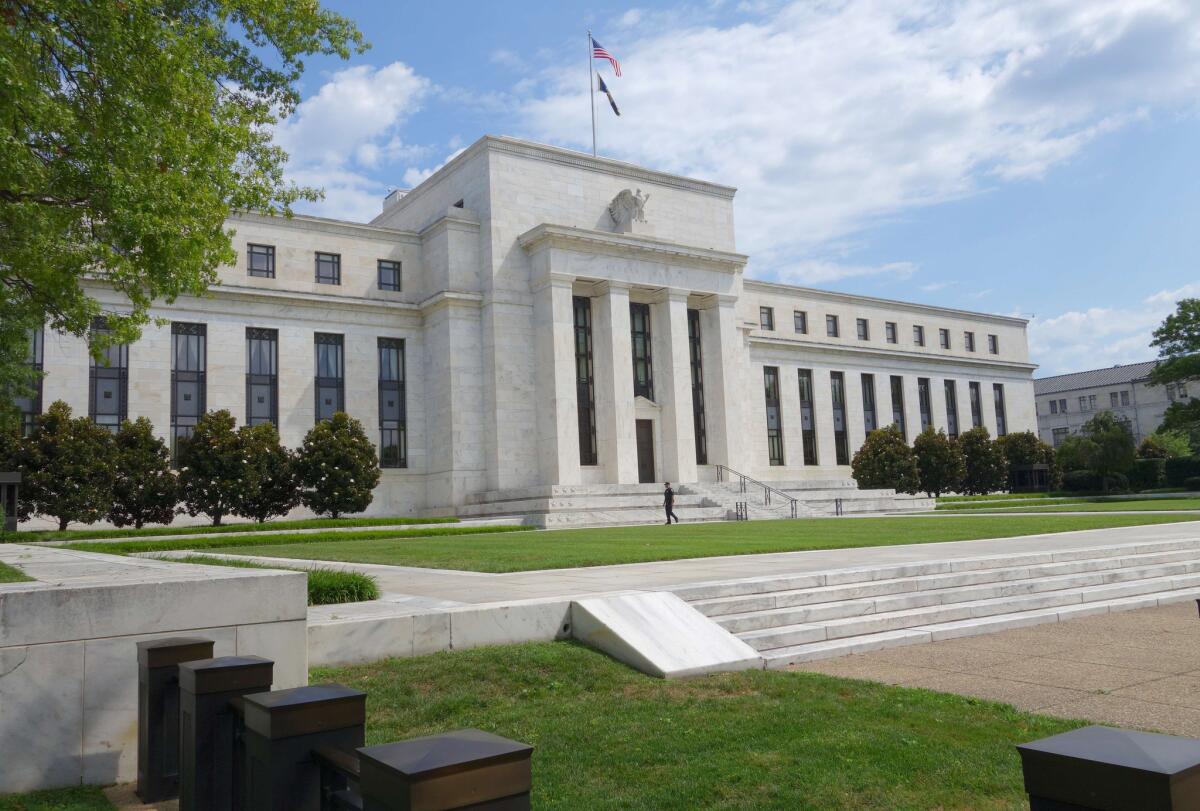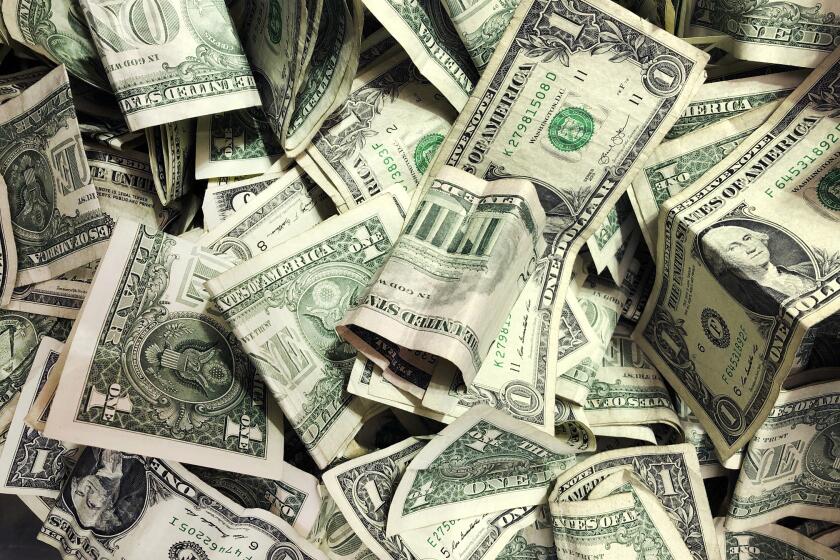Five things to watch for as the Federal Reserve makes its rate hike decision

The Federal Reserve building in Washington, D.C., is seen on Aug. 1.
- Share via
Reporting from Washington — The typical Federal Reserve monetary policy announcement has all the drama of a traffic signal.
Officials provide enough hints beforehand that there’s little surprise when the news comes about whether they have given the green light to an interest rate change.
That’s not the case Thursday.
Nearly a decade after the last increase in the benchmark federal funds rate — and after almost seven years of keeping it at the unprecedented level of near-zero — central bank policymakers will announce if the time has come for an increase.
Analysts said the potential for a rate hike is too close to call as the Federal Open Market Committee on Thursday wraps up its most eagerly awaited meeting in years.
There have been fewer than normal signals from Fed policymakers, including an unusual two months of public silence from Chairwoman Janet L. Yellen.
And the turmoil in financial markets that began in late August has dampened expectations that the Fed would raise the target level for the rate by 0.25 percentage point this month.
Here are five things to watch for when the Fed makes its announcement at 11 a.m. Pacific time, followed 30 minutes later by a news conference with Yellen.
NEWSLETTER: Get the day’s top headlines from Times Editor Davan Maharaj >>
One and done
In June and July, Yellen said she expected a rate hike this year, and most analysts put their money on September.
But that was before China devalued its currency late last month. The move, a signal that the Chinese economy was slowing, roiled financial markets. Many fear a Fed rate hike could add to the volatility.
The 0.25 percentage point increase in itself is minor.
“If the Fed moves the rates a quarter of a point, it probably isn’t going to have a significant impact in how CEOs invest and hire over the next 12 months,” AT&T Inc. Chief Executive Randall Stephenson said this week.
But the expectation has been that once the Fed started raising the rate, it would continue with 0.25 percentage point increases at just about every meeting for the near future.
That would be part of a long, slow climb back to about the 3% level the rate averaged from 2001 to 2007.
If the Fed goes ahead with a rate hike Thursday, it could try to soften the impact by signaling there won’t be another increase for a while.
Some analysts have called that a “one and done” rate hike.
Policymakers could indicate that approach in their policy statement. They also could show that in their estimations in the accompanying quarterly economic projections, which contain each member’s evaluation of where the federal funds rate would be at the end of the year.
Or Yellen could simply state it when she addresses reporters after the meeting.
Split the baby
If Fed officials are torn between a 0.25 percentage point rate hike or no rate hike at all, some think they could split the difference with a mini-hike of 0.125 percentage point.
The Fed frequently moved the rate by increments of an eighth of a point in the 1970s and ‘80s. But it hasn’t made such a minor move since 1989.
It’s unclear whether a mini-hike would make everyone happy. It could end up upsetting both those wanting a rate hike and those opposed to one.
But don’t be shocked if the rate moves up by less than 0.25 percentage point.
All aboard
On a major policy decision like the first rate hike since 2006, Yellen will strive for consensus.
Recent Fed history shows that will be difficult to obtain.
Jeffrey Lacker, president of the Federal Reserve Bank of Richmond, Va., one of the 10 voting members of the FOMC, could be a dissenter if the committee votes to hold the rate steady.
He said this month that “it’s time to align our monetary policy with the significant progress we have made.”
On the other side, John Williams, president of the Federal Reserve Bank of San Francisco, warned this month of “pretty significant” headwinds for the U.S. economy that have “grown larger” recently.
And the committee’s vice chair, William Dudley, president of the Federal Reserve Bank of New York, said late last month that the case for a September rate hike had become “less compelling” amid concerns about the global economy.
Dudley, a close ally of Yellen’s, is unlikely to dissent if the rate is raised. But Williams could.
Yellen probably will try for a unanimous vote to send a clear signal to financial markets about the Fed’s view of the economy. Getting such a vote could be a big accomplishment.
SIGN UP for the free California Inc. business newsletter >>
Market reaction
The lack of clear signals from the Fed about what it will do Thursday could translate into a wild ride on Wall Street and in financial markets abroad after the news breaks.
By one indicator based on federal funds futures, investors believe there is only about a 30% chance of a rate hike. So if the Fed increases the rate, markets would be expected to nosedive.
Adding more volatility to an already roiled financial marketplace is a reason some analysts believe Fed policymakers will wait to increase the interest rate.
In addition to its dual mandate of maximizing employment and keeping inflation in check, the Fed has had an unwritten third mandate since the Great Recession: financial stability.
“The worry surrounding a rate hike really centers around how it might affect financial markets abroad, especially in emerging market countries such as China,” said John Lonski, chief economist at Moody’s Capital Markets Research Group.
“They probably don’t want to go ahead and add to financial market volatility at this point in time,” he said.
But survey results Wednesday from CNBC showed 49% of the 51 economists, money managers and strategists the business news network polled think the Fed will increase the rate.
About 43% think the hike will come later, with the rest undecided.
That would point to a market decline if the Fed doesn’t act.
But some argue removing the questions about when the Fed would raise the rate would do more for financial stability, particularly in the long-term, than holding steady.
“It’s this deep uncertainty surrounding the conduct of monetary policy that is exacerbating swings in financial markets,” said Lawrence Goodman, a former Treasury official who is president of the Center for Financial Stability think tank.
Political fallout
The Fed’s decision will reverberate around the globe. But some of the biggest reactions could come from within Washington.
Liberals have been calling for Yellen and her colleagues to delay a rate increase, arguing the economy still is too weak.
Fed Up, a coalition of 25 labor, community and liberal activist groups plan a news conference Thursday morning in front of the building where Yellen will meet with reporters. The group plans to make its case that the Fed should wait until there is more improvement in the jobs market.
Liberal activists pushed for Yellen to be made Fed chair over former Treasury Secretary Lawrence H. Summers, and they’ll be upset with a rate increase this month.
Summers recently said that a rate increase now would be “a serious mistake.” His comments echoed warnings from the World Bank.
But holding the rate steady carries its own political risks.
Many Republicans have been highly critical of the Fed’s actions since the Great Recession. They’ve pushed to change the law to allow for audits of the Fed’s monetary policy decisions and require the central bank to set rules for adjusting the federal funds rate.
“Our economy would be healthier if the Federal Reserve were more predictable in its conduct of monetary policy and more transparent about its decision-making,” said Rep. Jeb Hensarling (R-Texas), chairman of the House Financial Services Committee.
Whichever way the Fed goes Thursday, Yellen will face heat for the decision the next time she testifies on Capitol Hill.
Follow @JimPuzzanghera on Twitter
ALSO:
Average rate on 30-year mortgage rises
General Motors fined $900 million over faulty ignition switches
Amazon introduces new tablet computer for less than $50
More to Read
Inside the business of entertainment
The Wide Shot brings you news, analysis and insights on everything from streaming wars to production — and what it all means for the future.
You may occasionally receive promotional content from the Los Angeles Times.











